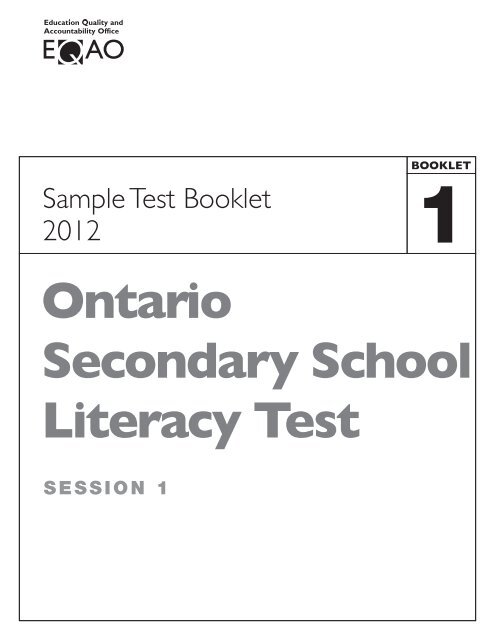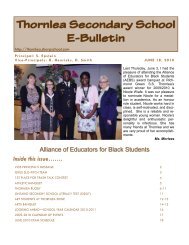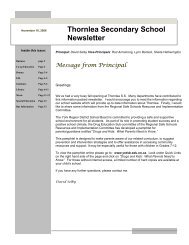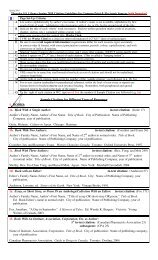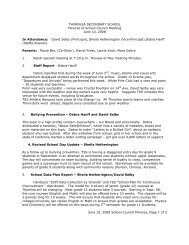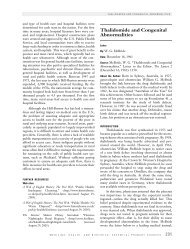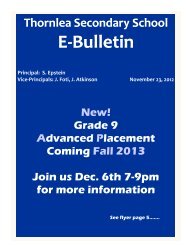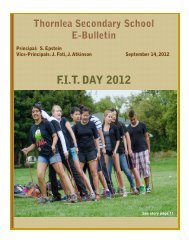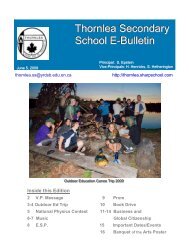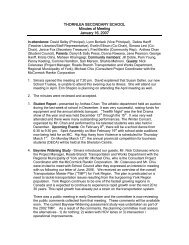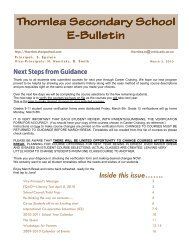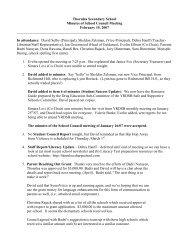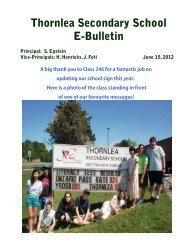OSSLT Sample Test Booklet 1 2012.pdf - Thornlea
OSSLT Sample Test Booklet 1 2012.pdf - Thornlea
OSSLT Sample Test Booklet 1 2012.pdf - Thornlea
Create successful ePaper yourself
Turn your PDF publications into a flip-book with our unique Google optimized e-Paper software.
BOOKLET<br />
<strong>Sample</strong> <strong>Test</strong> <strong>Booklet</strong><br />
2012<br />
1<br />
Ontario<br />
Secondary School<br />
Literacy <strong>Test</strong><br />
SESSION 1
Ontario Secondary School Literacy <strong>Test</strong><br />
Read carefully before writing the test:<br />
• Check the identification numbers of your three documents to see that the final 12 digits all<br />
match. If they do not, report the problem to the teacher in charge.<br />
• Check the pages of this <strong>Test</strong> <strong>Booklet</strong> to see that they are in order. If they are not, report the<br />
problem to the teacher in charge.<br />
• Read all instructions before responding to the questions.<br />
• Use only pencil or blue or black pen in the <strong>Test</strong> <strong>Booklet</strong> and on the Student Answer Sheet.<br />
• Attempt all questions. If you leave a question blank, the question will be scored zero.<br />
Multiple-Choice<br />
• Choose the best or most correct answer for each question.<br />
• You must record your multiple-choice answers on the Student Answer Sheet. Multiple-choice<br />
answers recorded in the <strong>Test</strong> <strong>Booklet</strong> will not be scored.<br />
To indicate your answer, fill in the circle completely, as shown below.<br />
Like this:<br />
Not like this:<br />
• If you fill in more than one circle for a question, the question will be scored incorrect.<br />
• If you wish to change a multiple-choice answer, erase or cross out your answer and fill in the<br />
circle for your new answer. Ensure that your final answer is clear.<br />
Written Answers<br />
• For all questions that ask for a written answer, write legibly on the lined space provided<br />
in the <strong>Test</strong> <strong>Booklet</strong>.<br />
• For the writing sections, pay attention to clarity, organization, spelling, grammar and<br />
punctuation.<br />
• The lined space provided for your written work indicates the approximate length of the<br />
writing expected.<br />
• There is space in the <strong>Test</strong> <strong>Booklet</strong> for rough notes. Nothing you write in these spaces will<br />
be scored.<br />
You are now ready to start <strong>Test</strong> <strong>Booklet</strong> 1: Session 1.<br />
Remember to record all your multiple-choice answers on the Student Answer Sheet.<br />
<strong>Sample</strong> <strong>Test</strong> <strong>Booklet</strong>: Session 1
Ontario Secondary School Literacy <strong>Test</strong><br />
Session 1<br />
<strong>Sample</strong> <strong>Test</strong> <strong>Booklet</strong>: Session 1
Section A: Reading<br />
Ontario Secondary School Literacy <strong>Test</strong><br />
Read the selection below and answer the questions that follow it.<br />
Greasing the Wheels of Change<br />
Since starting their road trip in British<br />
Columbia on October 1, 2008, Cloe<br />
Whittaker and Tyson Jerry have stopped<br />
at many fast-food restaurants. But the<br />
pair aren’t breaking for snacks—they’re<br />
refuelling their van.<br />
Under the name “Driven to Sustain,” the<br />
two young environmentalists are driving<br />
across each province, territory and state in<br />
Canada and the U.S. and then into Mexico<br />
in a van powered by vegetable oil. The van<br />
can travel 8 km on a litre of this fuel.<br />
The couple obtain used oil free from<br />
local restaurants, saving hundreds of<br />
dollars and carbon emissions. “People<br />
behind us say the van smells like barbecue,<br />
but to me, it’s not an obvious difference,”<br />
Whittaker said.<br />
The pair hope to set a world record<br />
for the longest journey by car using<br />
alternative fuel, with a goal of covering<br />
45 000 kilometres in about six months.<br />
The title currently belongs to four Germans,<br />
who drove 38 137 kilometres on natural gas<br />
two years ago.<br />
1<br />
2<br />
3<br />
4<br />
Growing up around Georgian Bay<br />
inspired Jerry’s respect for nature. He<br />
worked as a tree planter while studying<br />
environmental management. Whittaker<br />
grew up camping in the prairies. She<br />
finished her degree in anthropology and<br />
environmental studies a year ago. The pair<br />
met last summer and realized they shared<br />
goals for sustainable living.<br />
“We’re not looking to become famous,”<br />
Jerry said.<br />
“We want to convey the idea that people<br />
have a choice. We have this incredible<br />
technology [for the car], but really, change<br />
has to come from people’s mentalities,”<br />
Whittaker said after meeting with the student<br />
ecological club at an Ontario high school.<br />
5<br />
6<br />
7<br />
Adapted from “Greasing the wheels of change” by Paola Loriggio, published in the Toronto Star, November 25, 2008. Reprinted with<br />
permission —Torstar Syndication Services.<br />
2 <strong>Sample</strong> <strong>Test</strong> <strong>Booklet</strong>: Session 1
Ontario Secondary School Literacy <strong>Test</strong><br />
Section A: Reading<br />
Multiple-Choice (Record the best or most correct answer on the Student Answer Sheet.)<br />
1 According to the selection, why did Whittaker<br />
and Jerry make frequent stops?<br />
A<br />
B<br />
C<br />
to present their ideas<br />
to buy some fast food<br />
to give their van a rest<br />
D to obtain used cooking oil<br />
2 Why were Whittaker and Jerry working<br />
together?<br />
F<br />
G<br />
They loved fast food.<br />
They grew up together.<br />
H They had similar beliefs.<br />
J<br />
They planted trees together.<br />
5 Which event described in the selection<br />
happened first?<br />
A<br />
B<br />
C<br />
The road trip began in British Columbia.<br />
Whittaker and Jerry met during the<br />
summer.<br />
A German car using alternative fuel set<br />
a world record.<br />
D Whittaker finished her university<br />
degree in anthropology.<br />
Turn the page to complete this section.<br />
3 What was the environmental benefit of the<br />
“Driven to Sustain” project?<br />
A<br />
B<br />
C<br />
It used natural gas.<br />
It reduced fuel costs.<br />
It recycled a waste product.<br />
D It resulted in a better-smelling emission.<br />
4 What word is closest in meaning to “convey”<br />
as used in paragraph 7?<br />
F<br />
G<br />
carry<br />
change<br />
H continue<br />
J<br />
communicate<br />
<strong>Sample</strong> <strong>Test</strong> <strong>Booklet</strong>: Session 1 3
Section A: Reading<br />
Ontario Secondary School Literacy <strong>Test</strong><br />
Written Answer<br />
6 Did Whittaker and Jerry choose an effective way to promote their message? Use specific details from<br />
the selection to support your answer.<br />
Rough Notes<br />
Use the space below for rough notes. Nothing you write in this space will be scored.<br />
End of Section A.<br />
Continue to Section B.<br />
4 <strong>Sample</strong> <strong>Test</strong> <strong>Booklet</strong>: Session 1
Ontario Secondary School Literacy <strong>Test</strong><br />
Section B: Writing<br />
Multiple-Choice (Record the best or most correct answer on the Student Answer Sheet.)<br />
1 Which sentence does not belong in the<br />
following paragraph?<br />
(1) In keeping with tradition, the Olympic<br />
flame burned throughout the 2010 Vancouver<br />
Games. (2) The flame was flown to Canada<br />
from Greece and relayed across the country<br />
by 12 000 runners. (3) Imagine running over<br />
rough terrain with a torch in hand. (4) The<br />
flame even travelled by boat, snowmobile and<br />
dogsled. (5) It was extinguished at the closing<br />
ceremonies to signal the end of the games.<br />
A sentence 2<br />
B sentence 3<br />
C sentence 4<br />
D sentence 5<br />
2 Choose the sentence that best combines the<br />
following sentences.<br />
Computers are useful tools.<br />
Computers allow students to keep their<br />
homework neat.<br />
Computers are too expensive for some<br />
students.<br />
F<br />
G<br />
Computers are useful tools, but they<br />
are too expensive for some students.<br />
Students can keep their homework neat<br />
because computers are useful tools.<br />
H Although they are too expensive for<br />
some students, computers are useful<br />
tools that allow students to keep their<br />
homework neat.<br />
J<br />
Computers are useful tools for students,<br />
and they allow students to keep their<br />
homework neat, and they are too<br />
expensive for some students.<br />
3 What punctuation is missing from this sentence?<br />
If I wear my running shoes to school on<br />
an icy day I might slip and fall.<br />
A<br />
B<br />
C<br />
a colon<br />
a period<br />
a comma<br />
D a semicolon<br />
4 Choose the sentence that is written correctly.<br />
F<br />
G<br />
“Oh no” she exclaimed. “What will we<br />
do next?”<br />
“All right,” sighed Miguel, “we’ll try<br />
harder tomorrow.”<br />
H “Watch out!” cried Manuel, “The bus is<br />
coming right now!”<br />
J<br />
“Wow! Where did you find that beautiful<br />
dress” Sara asked?<br />
5 Which sentence is written correctly?<br />
A<br />
B<br />
Greg and him fixed the car.<br />
We told her and Sarah the news.<br />
C The bill was addressed to he and I.<br />
D Them and their parents paid for the repair.<br />
End of Section B. Continue to Section C.<br />
<strong>Sample</strong> <strong>Test</strong> <strong>Booklet</strong>: Session 1 5
Section C: Reading<br />
Ontario Secondary School Literacy <strong>Test</strong><br />
Read the selection below and answer the questions that follow it.<br />
The Six String Nation guitar symbolizes Canadian national unity. Radio host Jowi Taylor<br />
came up with the idea for the guitar in 1995. He asked George Rizsanyi, a luthier, to build<br />
a guitar from materials representing remarkable people and places, diverse geographic regions<br />
and natural wonders of Canada. For over 10 years, the two men gathered 64 pieces of<br />
wood, metal and bone to make the instrument. The front piece was made from the wood of<br />
a 300-year-old golden spruce tree, honoured by the Haida peoples of British Columbia.<br />
Other wood pieces came from the deck of the Bluenose II (a Nova Scotia sailing ship that<br />
appears on the Canadian dime) as well as from Paul Henderson’s hockey stick and former<br />
Prime Minister Pierre Trudeau’s canoe paddle. The most significant piece for Rizsanyi is<br />
an inside strut made from Pier 21. This is the Halifax dock where his family entered Canada.<br />
The guitar includes metal from a seat at Montreal’s famous arena, the Forum, and a gold dot<br />
from one of Maurice Richard’s Stanley Cup rings. It also contains pieces of the world’s oldest<br />
rock, found near Great Bear Lake, NWT, and a moose antler used in First Nations ceremonies.<br />
The finished guitar made its musical debut on Parliament Hill in Ottawa on July 1, 2006. Since<br />
this first performance, it has been on tour across the nation. Canadian musicians such as Feist,<br />
Hawksley Workman and Bruce Cockburn have performed with it. Six String Nation is a<br />
powerful representation of all Canadians, connecting people, their stories and their communities.<br />
5<br />
10<br />
15<br />
Adapted from “Guitar Hero,” published in CAA Magazine, May 2008. Reprinted with permission. Photo: © Jonathan Haywood/CP Images.<br />
6 <strong>Sample</strong> <strong>Test</strong> <strong>Booklet</strong>: Session 1
Ontario Secondary School Literacy <strong>Test</strong><br />
Section C: Reading<br />
Multiple-Choice (Record the best or most correct answer on the Student Answer Sheet.)<br />
1 Which of the following was used in the guitar<br />
to represent one of the “natural wonders of<br />
Canada” (line 4)?<br />
A<br />
B<br />
C<br />
wood from a 300-year-old tree<br />
wood from Pierre Trudeau’s paddle<br />
wood from the deck of the Bluenose II<br />
D wood from Paul Henderson’s hockey<br />
stick<br />
2 How are the descriptive details in lines 5 to 13<br />
grouped?<br />
F<br />
G<br />
by the age of the pieces<br />
by the types of materials<br />
H by the steps in construction<br />
J<br />
by the importance of the components<br />
3 Which line shows the use of a comma to<br />
separate items in a list?<br />
A line 3<br />
B line 6<br />
C line 11<br />
D line 14<br />
5 What is the most likely reason it took over<br />
10 years to build the Six String Nation guitar?<br />
A<br />
B<br />
C<br />
The guitar required exactly 64 pieces.<br />
The materials had to be chosen carefully.<br />
Taylor had to get permission from<br />
parliament.<br />
D Several guitar makers contributed to<br />
the process.<br />
6 What is the purpose of this selection?<br />
F<br />
G<br />
to persuade readers to listen to the guitar<br />
to provide facts about the parts of the<br />
guitar<br />
H to describe the steps in the construction<br />
of the guitar<br />
J<br />
to explain the reasons why musicians<br />
want to play the guitar<br />
Turn the page to complete this section.<br />
4 Why was July 1, 2006, an important date for<br />
the Six String Nation guitar?<br />
F<br />
G<br />
Feist played the guitar that day.<br />
The guitar’s construction was finished.<br />
H Canada Day was celebrated on<br />
Parliament Hill.<br />
J<br />
It was the first time the guitar was<br />
played for an audience.<br />
<strong>Sample</strong> <strong>Test</strong> <strong>Booklet</strong>: Session 1 7
Section C: Reading<br />
Ontario Secondary School Literacy <strong>Test</strong><br />
Written Answer<br />
7 State a main idea of this selection and provide one specific detail from the selection that supports it.<br />
Rough Notes<br />
Use the space below for rough notes. Nothing you write in this space will be scored.<br />
End of Section C. Continue to Section D.<br />
8 <strong>Sample</strong> <strong>Test</strong> <strong>Booklet</strong>: Session 1
Ontario Secondary School Literacy <strong>Test</strong><br />
Section D: Writing<br />
Short Writing Task (Answer in full and correctly written sentences.)<br />
1 Should every teenager join a team or club? Use specific details to explain why or why not.<br />
Rough Notes<br />
Use the space below for rough notes. Nothing you write in this space will be scored.<br />
End of Section D. Continue to Section E.<br />
<strong>Sample</strong> <strong>Test</strong> <strong>Booklet</strong>: Session 1 9
Section E: Writing<br />
Ontario Secondary School Literacy <strong>Test</strong><br />
Writing a News Report<br />
1<br />
Task:<br />
Purpose and<br />
Audience:<br />
Length:<br />
Write a news report on the next page based on the headline and picture below.<br />
• You will have to make up the facts and information to answer some or<br />
all of the following questions: Who? What? Where? When? Why? How?<br />
• You must relate your newspaper report to both the headline and the picture.<br />
to report on an event for the readers of a newspaper<br />
The lined space provided for your written work indicates the approximate<br />
length of the writing expected.<br />
Volunteers Help with<br />
Community Project<br />
Rough Notes<br />
Use the space below for<br />
rough notes. Nothing<br />
you write in this space<br />
will be scored.<br />
Write your report on the lines provided on the following page.<br />
10 <strong>Sample</strong> <strong>Test</strong> <strong>Booklet</strong>: Session 1
Ontario Secondary School Literacy <strong>Test</strong><br />
Section E: Writing<br />
Volunteers Help with Community Project<br />
End of Section E. Continue to Section F.<br />
<strong>Sample</strong> <strong>Test</strong> <strong>Booklet</strong>: Session 1 11
Section F: Reading<br />
Ontario Secondary School Literacy <strong>Test</strong><br />
Read the selection below and answer the questions that follow it.<br />
Canada is a country that champions itself as a world leader in multiculturalism and<br />
diversity. Why then does it continue to have a national holiday to honour a British<br />
monarch who died 107 years ago while it doesn’t have a single national holiday to honour<br />
a Canadian? Canada is almost the last country to mark Victoria Day. Even the British<br />
don’t commemorate it. Instead, they celebrate the Queen’s Birthday on a June Saturday,<br />
not a weekday. Countries change, as Canada has. Canada started celebrating Victoria’s<br />
birthday in 1845, when it was still a British territory. Part of the transformation for Canada<br />
has been to drop the notion that we are tied to Britain. True, Queen Elizabeth II is our<br />
head of state, but polls indicate just five percent of us know that. Quebec has had several<br />
names for the day, and now calls it Patriots’ Day, to commemorate those who struggled<br />
for democratic government during the Lower Canada Rebellion of 1837–1838. The United<br />
States has Presidents’ Day and Martin Luther King Day. We could have Prime Ministers’<br />
Day, or maybe Jacques Cartier Day or Peacekeepers’ Day. The choices for a new name<br />
are endless, but the point is simple: It is time to stop calling the May holiday Victoria Day.<br />
We should not get rid of the holiday Monday; everybody loves long weekends. However,<br />
we need to rename it for a person or event with more meaning to a modern Canada.<br />
5<br />
10<br />
15<br />
Adapted from “Let’s get rid of Victoria Day” by Bob Hepburn, published in the Toronto Star, May 15, 2008. Reprinted with permission—Torstar<br />
Syndication Services.<br />
12 <strong>Sample</strong> <strong>Test</strong> <strong>Booklet</strong>: Session 1
Ontario Secondary School Literacy <strong>Test</strong><br />
Section F: Reading<br />
Multiple-Choice (Record the best or most correct answer on the Student Answer Sheet.)<br />
1 Which is a holiday that is currently celebrated<br />
in Canada?<br />
A<br />
B<br />
C<br />
Patriots’ Day<br />
Peacekeepers’ Day<br />
Jacques Cartier Day<br />
D Prime Ministers’ Day<br />
2 What word is closest in meaning to<br />
“commemorate” as used in line 5?<br />
F<br />
G<br />
want<br />
need<br />
H question<br />
J<br />
recognize<br />
3 Beginning the sentence with “True” (line 8)<br />
indicates that the writer is<br />
A<br />
B<br />
C<br />
changing his mind.<br />
recognizing a different viewpoint.<br />
trying to correct a misunderstanding.<br />
D providing a fact to support his opinion.<br />
5 Why are so many holidays mentioned in this<br />
selection?<br />
A<br />
B<br />
C<br />
to provide examples for Canada to<br />
consider<br />
to show that the good holiday names<br />
are taken<br />
to emphasize that Canada has too many<br />
holidays<br />
D to list other holidays the author is<br />
concerned about<br />
6 This selection is an example of a<br />
F<br />
G<br />
story.<br />
dialogue.<br />
H news report.<br />
J<br />
supported opinion.<br />
Turn the page to complete this section.<br />
4 Which holiday celebrates one individual rather<br />
than several people?<br />
F<br />
G<br />
Patriots’ Day<br />
Presidents’ Day<br />
H Queen’s Birthday<br />
J<br />
Peacekeepers’ Day<br />
<strong>Sample</strong> <strong>Test</strong> <strong>Booklet</strong>: Session 1 13
Section F: Reading<br />
Ontario Secondary School Literacy <strong>Test</strong><br />
Written Answer<br />
7 State a main idea of this selection and provide one specific detail from the selection that supports it.<br />
Rough Notes<br />
Use the space below for rough notes. Nothing you write in this space will be scored.<br />
End of <strong>Booklet</strong> 1.<br />
14 <strong>Sample</strong> <strong>Test</strong> <strong>Booklet</strong>: Session 1
© 2012 Queen’s Printer for Ontario<br />
Education Quality and Accountability Office<br />
2 Carlton Street, Suite 1200<br />
Toronto, Ontario M5B 2M9<br />
Telephone: 1-888-327-7377<br />
Web site: www.eqao.com


